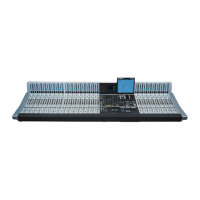D950 Digital Mixing System
Date printed: 03.09.03 SW V3.3 Getting started 2-5
2.3 System Startup and Shutdown
System Startup Basically, the D950 Series Digital Mixing system should be wired on one
master power switch. There is no specific order in which the D950's sys-
tem components have to be powered up.
Referring to the external PC monitor, first check the location of the various
system utilities and applications. If the D950 System icon is in the Win-
dows NT Startup directory, the application will be automatically started.
Otherwise, start the system by double-clicking on the D950 System icon or
shortcut. You might also start the D950 System application from the Win-
dows Start menu.
System Shutdown Please ensure that the D950 System application and all other Windows
applications are terminated before you initialize Windows NT shutdown
procedure. Only power-off when you see the familiar “It is now safe to
turn off your computer” message on the monitor.
Note: Please refer to the Graphic Controller, chapter 4, for more information.
Because each D950 every console is configured differently, there may be
other procedures necessary for reliable startup and shutdown for your par-
ticular system.
2.4 Basic Operating Principles
2.4.1 Operating Desk Concept
Opinions are often divided on how Virtual DSP channels should be corre-
lated with the physical channel strips located in front of the operator. One
design philosophy is to install a single fader strip for each audio channel;
this approach comes close to mimicking the familiar layout of an analog
mixing console – operating “layers” or assignability are not required. Us-
ing this method the D950 can be made to emulate inline consoles, classic
split consoles, or any variation in between.
By contrast, many users prefer smaller operator control surfaces, for ex-
ample, equipped with 24 dual-layer fader strips for 48 channels. In this
case, simple assignability plays a major role during operation.
The Studer D950 Series supports both philosophies. It is possible to oper-
ate each channel individually, or to allocate up to 10 physical channels to
each fader strip. In an extreme example, 120 channels could be controlled
with just 12 faders. The specific strip setup is held within the D950’s data
storage system; so it can be permanently stored, modified, and later re-
called. In other words, it is no longer necessary to define the channel or-
ganization at the time of ordering the D950 mixing console; since changes
are possible at any time.
Setting parameters of a channel located relatively off-axis from the con-
sole’s central “sweet spot” is often difficult, because the engineer needs to
move away from the optimum listening zone and then back aging to check

